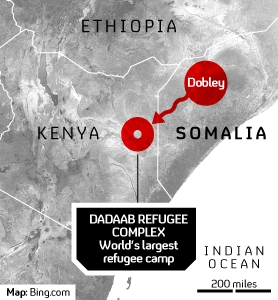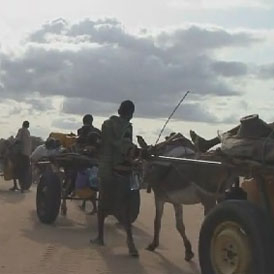The long walk to Dadaab for Somalia’s refugees
 Jamal Osman
Africa Correspondent
Jamal Osman
Africa Correspondent
The British Somali journalist Jamal Osman experiences for himself just a little of the arduous trek being endured by thousands of starving Somalis making their way to the Dadaab refugee camp in Kenya.

Osman had himself fled Somalia on foot 20 years ago – escaping the violence and hunger that have repeatedly plagued his homeland. Now he has returned to southern Somalia to meet some of the families making a similarly perilous journey in a bid to help their families survive the drought of 2011.
He begins in the border town of Dobley, where families rest before pushing on to Kenya and the Dadaab refugee camp.
Once there was food and water here for thousands of cattle – but now all there is to be seen are the carcasses of dead animals – their bare bones revealing evidence of the plastic bags they’d eaten in the last stages of starvation.
One villager – Halimo Abdi – tells Osman: “Last year I had 500 goats, 60 cows and 50 camels. Now they are all gone. I have nothing.”
“Last year I had 500 goats, 60 cows and 50 camels. Now they are all gone. I have nothing.” Halimo Abdi
Further along the road, Osman meets a large group of people, piled high with their belongings, heading for Dadaab. The Ibrahim family are on the 16th day of a 300-mile journey from their home town of Dinsor, at the epicentre of the famine-hit area.
“There’s lots of fighting and hunger in Somalia,” says Abdi Ibrahim, the family’s elder. “We are going to Dadaab, where we hope to be safe and find food, education and medicine for our children.”

After another ten hours of walking, the group stop to set up camp for the night, settling down to cook the small amounts of food that have been donated along the route.
Among the group is a woman, Hawa Osman, with a baby – still less than a month old – hidden under her hijab.
As the group reach the Kenyan border next morning, she is desperate for a lift to take her the rest of the way. They come across a group of UN and other aid workers, scouting the area to set up a new transit camp where they can process the thousands of families fleeing the drought – but they cannot help with transport.
So the trek continues. As Osman leaves the group, they still have 50 miles to go to Dadaab – along a road frequented by bandits who regularly attack and loot the refugees.
But this journey, at least, is unhindered. The families reach Dadaab and join the thousands of others seeking food and shelter at the already-overcrowded facility.
Click here to donate to the Save The Children East Africa appeal. Or to donate to the DEC East Africa Crisis Appeal, click here, call the 24-hour hotline on 0370 60 60 900, or donate over the counter at any post office or high street bank.